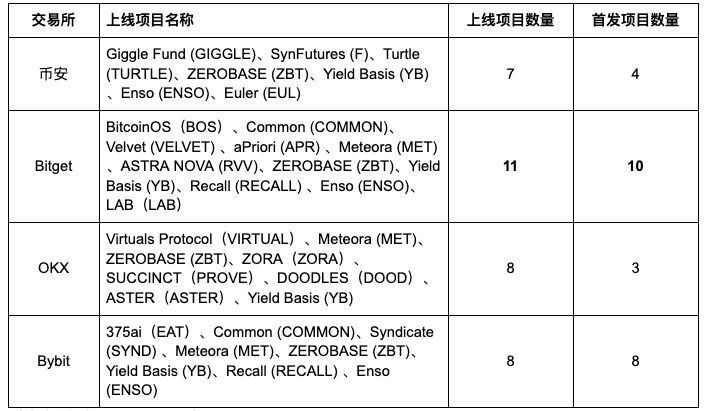Original author: WhiteRunner 
The “1011” incident ignited the entire crypto market, with $19.2 billion in contract liquidations occurring overnight, setting a historical record. In the following weeks, Bitcoin plummeted below $100,000, causing widespread devastation. Meanwhile, major exchanges launched a series of actions.
A Recap of the "1011" Incident: The Largest Liquidation in Crypto History
October 11, 2025, will forever be etched in the annals of cryptocurrency history. The global crypto market experienced its darkest six hours ever. Following US President Trump's announcement of a 100% tariff on Chinese goods, the market erupted in panic selling, triggering a chain reaction of liquidations. Within 24 hours, the contract market saw a staggering $19.2 billion in liquidations, setting a new record for the largest liquidation in cryptocurrency history. This not only surpassed the $3 billion record set in the "312 Massacre" of 2020 but also exceeded the combined total of previous major liquidations. Bitcoin plummeted by approximately 13.5% in a short period, with numerous altcoins crashing and some small-cap tokens nearly reaching zero. After several weeks of volatility, the market experienced another sharp decline on November 4th, with Bitcoin falling below the $100,000 mark to a near five-month low, reigniting despair among retail investors. These events shook market trust in the security and compliance mechanisms of exchange assets, prompting a large influx of funds to leading platforms seeking greater transparency and risk protection.
Following the 1011 incident, major exchanges Binance, Bitget, OKX, and Bybit almost simultaneously launched countermeasures. As market confidence gradually recovered, the "listing pace" became an important signal for exchanges to demonstrate trust and execution capabilities. Each platform conveyed its stability and selection criteria through different strategies, but the goal was the same: to rebuild user trust through transparency, project quality, and risk control systems. Listing activities during this period also shifted from "traffic competition" to a contest of risk control capabilities and ecosystem resilience, marking the beginning of a new phase in the cryptocurrency industry centered on "compliance, stability, and value selection."
This article will analyze the underlying causes, strategic differences, and potential impacts of this series of activities, attempting to reconstruct the exchange game framework behind the events and provide key indicators for subsequent observation.
Overview of major exchanges
From a data perspective, from October 11th to 31st, 2025, the four major exchanges listed more than 30 projects, setting a new high for the year. This not only reflects the speed at which exchanges regain confidence, but also reveals the differentiated strategic directions of each platform.
The following is an overview of the overall data: 
(Statistics period: October 11-31)
As can be seen, Bitget stands out with 11 listed projects, 10 of which are first-time listings, and an average market capitalization of $280.6 million for each first-time listing, making it the most outstanding performer. Although Binance has fewer first-time listings, its projects generally possess BSC ecosystem attributes, reflecting its strategic focus. OKX has chosen mostly high FDV projects, such as ZORA and SUCCINCT, indicating its continued reinforcement of its positioning as a "high-end project aggregation hub." Bybit, on the other hand, has used an extreme strategy of listing an extreme number of projects to grab market attention, but the market capitalization of its projects has fluctuated significantly.
The listing landscape at this stage reflects the accelerating formation of "positioning differentiation" among exchanges: Binance maintains its ecosystem moat; Bitget focuses on the quality and speed of initial listings; OKX emphasizes stability and brand trust; and Bybit pursues traffic and short-term gains.
Therefore, in the coming period, investors need not only to "find projects", but also to choose "which platform to find the right projects".
Binance: Seeking stability while adapting to change and building its ecosystem.
Binance maintained its consistently steady pace. Between October 11th and 31st, Binance listed a total of 7 projects, 4 of which were initial public offerings (IPOs), with an average initial market capitalization of $267.3 million.
Binance's initial selection logic differs significantly from other exchanges: it prioritizes projects with high relevance to the BSC ecosystem, such as Giggle Fund (GIGGLE) and SynFutures (F), which are closely linked to its on-chain ecosystem, aiming to strengthen its own ecosystem moat and consolidate the long-term value system that the BSC chain is striving to build.
While Binance's performance in October wasn't spectacular, it was steady and precise, representing the typical characteristics of a mature exchange: prioritizing listing fewer tokens over ensuring each listed project aligns with its ecosystem goals. For investors, choosing Binance's initial offerings may not yield the same rapid returns as Bitget, but it offers higher certainty, lower volatility risk, and stable long-term value.
Bitget: Building a High-Quality First-Launch Moat
If the October coin listing battle was a clash of titans, then Bitget was undoubtedly the star of the month. From October 11th to 31st, Bitget listed 11 projects, 10 of which were first-time listings, covering multiple sectors—from DeFi and AI to GameFi.
Meanwhile, the quality and market capitalization of tokens listed on Bitget far surpass those of its peers. Its initial public offerings (IPOs) have an average FDV of $280.6 million USD, with a stable overall distribution: 5 projects have a market capitalization exceeding $200 million USD, the remaining projects are all above $80 million USD, and there are no "air coins" or low-market-cap tokens. Therefore, Bitget not only leads in quantity but also demonstrates superior quality.
Bitget's strategy is also very clear:
- Prioritize the launch of high-potential projects to seize the initial market share.
- Bitget Onchain's challenge mechanism provides a secondary listing channel for high-quality projects.
- Bitget spot trading is 100% listed on Binance Perp, becoming a "precursor station for Binance Perp".
For investors, this strategy means a stronger price discovery effect and a greater margin of safety. Once a project debuts on Bitget, it has essentially passed both market and risk control validation. This is why, starting in late October, Bitget can be considered a "new generation incubator for high-quality projects."
OKX: Focus on completing the ecosystem integrity
OKX launched a total of 8 projects, only 3 of which were first-time releases. While the number is not large, OKX's selection criteria primarily focus on high FDV (Fulfilled Direct Value) and high brand recognition, such as ZORA, SUCCINCT, and Virtuals Protocol. This reflects OKX's emphasis on maintaining brand quality and ecosystem integrity. For example, SUCCINCT (PROVE) corresponds to Layer 2, while DOODLES and ZORA correspond to NFTs, echoing OKX's recent strategy of expanding its Web3 ecosystem.
OKX is attempting to build its unique competitive advantage through an ecosystem-based approach.
Bybit: Pursuing Diversity and Short-Term Volatility
Bybit launched eight projects, all of which were initial offerings. However, the market capitalization of these initial offerings varied dramatically – the highest, Yield Basis (YB), had a FDV of $573 million, while the lowest, 375ai (EAT), had a mere $36 million, a difference of nearly 16 times. This huge disparity suggests that Bybit prioritizes diversity and potential for explosive growth in its project selection, rather than stability.
Bybit's strategy is similar to Bitget's: attracting short-term funds and high-risk-averse investors through a large number of initial public offerings (IPOs), a "traffic-driven listing logic." However, small-cap coins in Bybit's initial offerings tend to be more volatile, requiring investors to exercise relative caution.
Therefore, for ordinary investors, Bybit is suitable for a "short-term speculative" strategy—quickly identifying hot topics, participating in short-term price surges, and strictly setting profit targets and stop-loss orders.
Three key indicators investors should pay attention to
In today's cryptocurrency landscape, simply relying on rumors or hype is no longer sufficient to judge a project's quality. Understanding the listing logic behind exchanges and project data is key to reducing risk and increasing returns. The following three indicators are the most noteworthy investment references after 2025:
- FDV: FDV represents the total valuation of a project after all tokens have been fully released. An excessively high FDV implies limited short-term growth potential, while an excessively low FDV may reflect a lack of market trust. It is recommended to prioritize mid-sized projects with FDVs between 100MM and 400MM, offering the best balance between risk and potential.
- Balancing the Quantity and Quality of Initial IPOs: Frequent initial IPOs often indicate that an exchange is in an expansion cycle, but project quality remains important. It is recommended to pay attention to the exchange's "initial IPO density to project quality ratio," and to be cautious about listings with a high density of coins but low market capitalization.
- Subsequent development and ecosystem support: The completeness of an exchange's ecosystem is often reflected in the projects that are not its initial offerings. For example, OKX and Binance provide users with a multi-layered asset experience by completing project ecosystem development (NFT, DeFi, AI, etc.). It is recommended to prioritize investing in exchanges with a stable ecosystem development pace and the ability to collaborate with other leading exchanges.
In summary, investors should replace "emotionally driven, trend-following" operations with "data-driven, rational decision-making." Only by understanding the exchange's strategic direction and listing standards can investors find a stable anchor for returns amidst market volatility.
Data Trend Forecast: Three Main Trends That May Continue in Q4
Based on the listing data and market feedback in October, the exchange landscape in Q4 is expected to continue with the following three major trends:
- Binance may strengthen its ecosystem-based listing strategy: As activity on the BSC chain rebounds, Binance will tend to list more projects linked to the BSC ecosystem, such as GameFi and AI interactive assets. Its strategy will shift from "defensive repair" to "ecosystem expansion".
- Bitget's leading position in initial IPOs will be further strengthened: the Onchain Transaction Challenge mechanism has attracted a large number of high-quality projects to apply for and qualify. It is expected that Bitget will maintain a pace of 1-2 initial IPOs per week in November, continuing to solidify its position as the "king of initial IPOs".
- Bybit and OKX will compete in the non-first-launch market: Bybit may begin to add some high FDV projects to its portfolio to enhance the platform's credibility; while OKX may moderately accelerate its launch schedule in an attempt to regain attention. This cross-competition will bring more vitality to the market in November.
Overall assessment: Q4 2025 will be a phase of "simultaneous initial public offerings and the completion of existing listings, and the joint development of trust and ecosystem." Exchange listing strategies are becoming more rational and systematic, and short-term market speculation will gradually give way to structural investment opportunities.
Opportunities in Crisis: Rebuilding Trust and Order Amidst Turmoil
The market crash since the 1011 incident plunged the market into despair, with many retail investors losing confidence amidst the continuous sharp fluctuations. However, it is precisely this reflection and adjustment during the crisis that has provided new opportunities for the market. Exchanges are gradually shifting from "speed competition" to "quality and structure competition," making the market more rational and balanced, and providing more choices for investors with different risk appetites.
The market recovery following the "1011" incident is a crucial period for rebuilding trust. Although the crash shook investors, the market did not completely collapse; instead, it has opened a window for rebirth. If investors can understand the listing strategies of exchanges and combine them with their own risk appetite, they still have the opportunity to obtain stable returns in future structural market trends.
However, this is not solely the responsibility of exchanges. Market recovery requires the joint efforts of both exchanges and retail investors. Exchanges need to enhance compliance and risk control to provide a safer platform, while the rationality and patience of retail investors are equally important. Only by maintaining confidence and working together can the cryptocurrency market emerge from its slump and usher in a more stable future.
- 核心观点:交易所通过差异化上币策略重建市场信任。
- 关键要素:
- Bitget首发10项目,平均市值2.8亿美元。
- 币安侧重BSC生态项目强化护城河。
- OKX选择高FDV项目完善生态布局。
- 市场影响:推动行业向合规稳健转型。
- 时效性标注:中期影响



